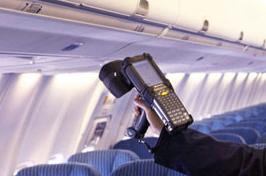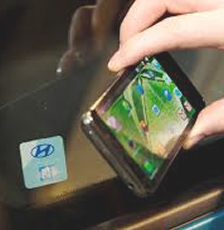

RFID solutions offer a number of unique benefits in such areas as asset identification, asset management and the capture of information throughout an entire process. RFID tags use wireless technology and do not require ‘line of sight’ to communicate with or to be read by an RFID reader, unlike barcodes which require clear ‘line of sight’ to be read. RFID tags can be embedded in a variety of assets and products including beer kegs, laundry items, concrete beams and pylons, fire doors and general window products plus a wide variety of safety equipment. RFID Technology is powerful, adding significant benefits, and when the tags and readers are optimised a variety of tasks can be quickly and accurately performed, for example stock takes that are potentially a lengthy and time consuming process can be completed in a fraction of the time using RFID technology with potential misplaced items being easier to identify.

In some processes and applications it is useful, possibly essential for an RFID tag to stay with an asset or product for its entire life cycle. The tags can be embedded in a product when requested by a customer and provide a unique means of identification and location for the life of the product. In the adjacent picture personal passenger safety equipment is being checked by the use of RFID tags and a hand held reader. RFID technology is proving extremely useful in distinguishing genuine products from ‘clone’ or counterfeit items. To confirm or validate that an item is genuine can be invaluable in cases involving warranty claims, repairs and safety procedures.

RFID technology can offer the same process transaction types that would normally be associated with a system using barcodes. For example the control and analysis of inventory levels and movements can be undertaken with RFID technology and associated equipment. With the added benefit that tags can be rugged, and are capable of being read by proximity rather than line of sight. Some tags allow for the reading and writing of data directly onto the tag. For example the last inspection date of a maintenance item, this data can then be stored locally on the item regardless of where it is locatated - be that on or off site. Other tags can have their own local battery power and can be used to monitor such things as temperature, useful when this is a key process parameter.
These are some typical RFID Projects:

Embedding RFID Tags allows the tag to be integrated into your products.

Specialist RFID tags can operate in harsh environments

Tags can store data and you can read / write multiple times

You can read multiple RFID Tags at once, allowing faster data collection.
Using a combination of embedded, surface mount and on-metal tags hand tools, machine tools, jigs etc. can be tracked. Projects have been undertaken where tags have been installed in plastic bodied hand tools including drills, tags have been inserted into torque wrenches, being put into the plastic handles or embedded into the metal body of the wrench and held with a hard epoxy filler cement. Machine tools and jigs have been tagged using either on metal or embedded tags. It is possible to track virtually any item using RFID technology provided that the correct tag is selected.
RFID tagging assets in a stores environment can bring a whole host of benefits, when assets have been tagged stock checking, stock takes, parts issuing and general asset locating and management becomes a quick and simple process. In stores dealing with high volume, low value issued items RFID tags can be very low cost high volume adhesive label type tags. Once again virtually all assets and stock can be precisely managed using RFID tag technology, selecting the correct tag for the required asset and usage is the main criteria.
Some assets will very likely never be issued or used, for example personal safety equipment such as lifejackets in aeroplanes or survival kits. As lives may depend upon such equipment one day it is vital however to track the equipment to make sure that, it is where it should be and available, it is still within the time frame that allows it to be used, whether or not it requires servicing repair or replacement. When the correct tag is selected for the various assets in such a situation tracking and uniquely identifying is not a time consuming exercise.
RFID technology has many uses in retail, from tagging items for security purposes to tagging the trolleys and baskets that are used around the store. GJBS have been involved with projects that involve RFID tagging trolleys and baskets and then tracking the movement of these using fixed readers with multiple antennae. The main usage was to determine when trolleys and baskets entered and left a store to determine how long they were in use and what length of time was spent in a store. If items such as garments are RFID tagged instore stock takes can be undertaken very quickly, a line of items hanging on a rack can be scanned and information obtained immediately about sizing, whether the current location is correct, in short a stock take can take a very short time.
GJBS supply a range of RFID tags that offer more functionality than just identification of an item, the tags that can provide this extra functionality have an onboard battery backup that is activated when the tag is installed. The tag uses the battery power to monitor and record environmental information which can be downloaded to a hand held or fixed reader when the tag is ‘interrogated’. For example the tag may be used to record the ambient temperature around an item and will be able to notify if both high and low specified temperatures have been exceeded or not kept to. There is frequently a misconception that these battery assisted tags will have a greater read range than a purely passive tag, this is not the case, the tag still activates on the received signal and energy from a reader. This is kept to legislated limits regarding power output, the tag has approximately the same read distance as a passive tag, the battery power is used to monitor and record.
Cloning of products can be a major problem in some industries and can have many implications when it comes to identifying products for repair or service. An RFID tag with a unique identity inserted into the product in the manufacturing process with the unique ID stored in the ‘TID’ memory (Transponder Identification Number) confirmation that the product is genuine can be easily obtained. The TID number is written to the RFID tag chip by the manufacturer and cannot be altered or erased or written to another tag without the massive investment of chip production equipment. This technology is widely in use in the automotive industry and is used to establish whether the correct parts i.e. gearbox are with the right vehicle. Traceability of this nature will also assist in the identification of stolen parts.